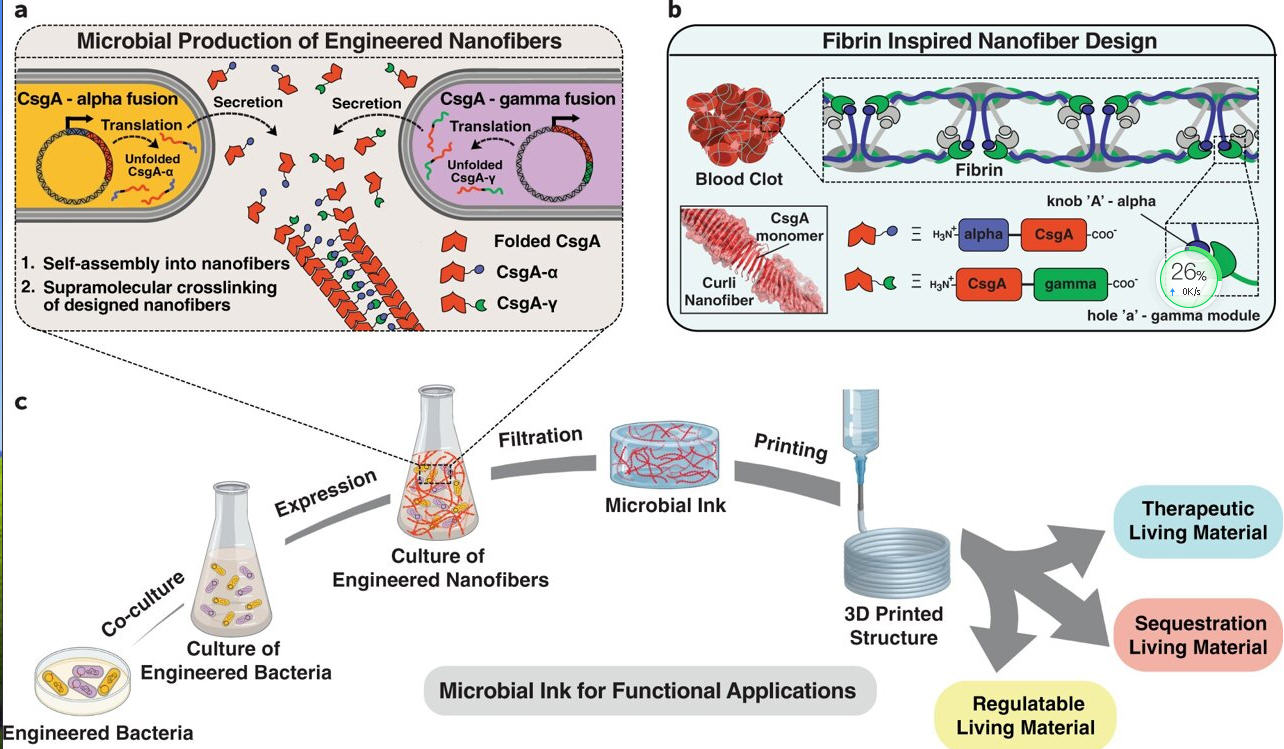博文
一种由活细胞制成的3D墨水,用于创造活结构
 精选
精选
||
一种由活细胞制成的3D墨水,用于创造活结构
诸平

Fig. 1: Schematics of the design strategy, production, and functional applications of microbial ink. a E. coli was genetically engineered to produce microbial ink by fusing α (knob) and γ (hole) protein domains, derived from fibrin to the main structural component of curli nanofibers, CsgA. Upon secretion, the CsgA-α and CsgA-γ monomers self-assemble into nanofibers crosslinked by the knob-hole binding interaction. b The knob and hole domains are derived from fibrin, where they play a key role in supramolecular polymerization during blood clot formation. c The protocol to produce microbial ink from the engineered protein nanofibers involves standard bacterial culture, limited processing steps, and no addition of exogenous polymers. Microbial ink was 3D printed to obtain functional living materials. Credit: DOI: 10.1038/s41467-021-26791-x
据物理学家组织网(Phys.org)2021年11月27日报道,来自美国哈佛大学(Harvard University)和哈佛医学院布里格姆妇女医院(Brigham and Women's Hospital, Harvard Medical School)的一组研究人员开发了一种由活细胞制成的3D墨水,用于创造活结构(A 3D ink made of living cells for creating living structures)。相关研究结果于2021年11月23日已经在《自然通讯》(Nature Communications)杂志网站发表——Anna M. Duraj-Thatte, Avinash Manjula-Basavanna, Jarod Rutledge, Jing Xia, Shabir Hassan, Arjirios Sourlis, Andrés G. Rubio, Ami Lesha, Michael Zenkl, Anton Kan, David A. Weitz, Yu Shrike Zhang, Neel S. Joshi. Programmable microbial ink for 3D printing of living materials produced from genetically engineered protein nanofibers. Nature Communications, 2021, Volume 12, Article number: 6600. DOI: 10.1038/s41467-021-26791-x. Published: 23 November 2021. http://dx.doi.org/10.1038/s41467-021-26791-x.在该论文中,研究者描述了他们如何制造这种墨水及其可能的用途。参与此项研究的除了来自美国哈佛大学和哈佛医学院布里格姆妇女医院的研究人员之外,还有来自美国东北大学(Northeastern University, Boston, MA, USA)研究人员。
多年来,微生物工程师们一直致力于开发一种方法,以创造出可用于广泛应用的生物材料,如医疗设备。但事实证明,让这些材料符合所需的3D结构是一项艰巨的任务。在这一新的努力中,研究人员采取了一种新的方法来解决这个问题,通过工程大肠杆菌(Escherichia coli)来生产一种产品,这种产品可以作为3D打印机中使用的油墨的基础。
这项工作开始于对细菌进行生物工程以产生有生命的纳米纤维。然后,研究人员将纤维捆绑在一起,并添加其他成分,生产出一种可用于传统3D打印机的活性墨水。一旦他们发现这个概念可行,这个研究团队就对其他微生物进行生物工程化处理,以生产其他类型的活纤维或材料,并将它们添加到墨水中。然后他们用这种墨水打印出有生命组件的3D物体。一种是这样一种物质,当受到某些化学物质的刺激时会分泌一种抗癌药物天青蛋白(azurin)。另一种是无需其他化学物质或设备就能隔离双酚A(Bisphenol A),它是一种已经进入环境的毒素。
研究人员认为,他们的概念表明,生产这种墨水可能是一个自我创造的命题。可以在微生物中加入工程技术,促使它们产生自身的碳副本,这种墨水可以在一个罐子里生长。他们还表示,这种技术似乎可以用于打印可再生建筑材料,这种材料不仅可以生长,而且可以自我修复,这是一种在地球上、月球上或火星上建造自给自足家园的可能方法。
上述介绍,仅供参考。欲了解更多信息,敬请注意浏览原文或者相关报道。
Living cells have the capability to synthesize molecular components and precisely assemble them from the nanoscale to build macroscopic living functional architectures under ambient conditions. The emerging field of living materials has leveraged microbial engineering to produce materials for various applications but building 3D structures in arbitrary patterns and shapes has been a major challenge. Here we set out to develop a bioink, termed as “microbial ink” that is produced entirely from genetically engineered microbial cells, programmed to perform a bottom-up, hierarchical self-assembly of protein monomers into nanofibers, and further into nanofiber networks that comprise extrudable hydrogels. We further demonstrate the 3D printing of functional living materials by embedding programmed Escherichia coli (E. coli) cells and nanofibers into microbial ink, which can sequester toxic moieties, release biologics, and regulate its own cell growth through the chemical induction of rationally designed genetic circuits. In this work, we present the advanced capabilities of nanobiotechnology and living materials technology to 3D-print functional living architectures.
https://blog.sciencenet.cn/blog-212210-1314484.html
上一篇:研究表明,相信占星术的人往往不太聪明,而且更自恋
下一篇:科学家发现阿尔茨海默病的潜在病因